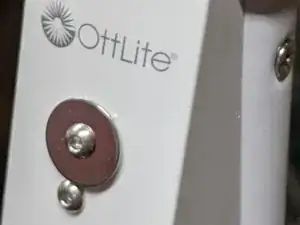Einleitung
The Ottlite PL-0094 Dual Shade LED Floor Lamp uses a touch switch to turn the light on and off and set the dimming levels.
The touch switch circuit appears to fail in a way that decreases the sensitivity such that the lamp can no longer be controlled.
Amazon 1-star reviews of the product suggest this is a common problem.
And the touch circuit replacement board does not appear to be available for purchase.
However, it turns out the touch sensor still works if one directly touches the contact for the touch sensor.
Simple fix: add a metal washer, machine screw, and nut to the touch switch area.
Werkzeuge
Ersatzteile
-
-
Place the lamp horizontally on a work surface
-
Unscrew the two screws above the control panel that hold the upper and lower parts of the lamp together
-
Slide up the control panel to remove
-
Unscrew the two screws that hold the power board in place
-
Use a soldering iron to gently melt the two plastic studs that hold the touch sensor circuit board in place
-
Remove the touch sensor button. It's not really an electrical or mechanical button; it's just decorative.
-
Install a small fender washer, machine screw and nut. Drill a small hole in the center of the control panel where the touch sensor button is placed.
-
Drill out the bottom plastic stud for the touch sensor circuit board mount.
-
-
-
Replace the touch sensor circuit board.
-
Use a small machine screw and nylon nut to secure the touch sensor circuit board.
-
Be sure the conductive foam is making contact with the screw and nut that is holding the fender washer.
-
Re-install the power circuit board
-
Re-assemble the lamp.
-
To reassemble your device, follow these instructions in reverse order.
17 Kommentare
wayne i found this outtlight in the trash i tried to buy a switch of course there are none, anyway found your post and thought i would give it a try ..and it works thank you for spending time sharing the fix howie
Glad the fixed worked for you, Howie!
- Wayne
Boulder U-Fix-It Clinic [http://boulderufixiticlinic.org]
Once you take the circuit board off of being mounted is there a way to test to make sure the light so works? We can't tell if the circuit board is the problem or not.
Jaclyn -
If you touch the conductive foam attached to the circuit board, you should be able to turn the lamp on/off/dim.
Thank you for your helpful guide. I am new to repair and stuck on the 5th step --the two plastic studs that hold the touch sensor circuit board in place--because I can not locate the two plastic studs. When I look behind sensor board, I only see a small white plastic square in the center above a grey round piece of fabric. One end of the white plastic square is attached to the sensor board and the other is attached white plastic housing and it moves in when pressed --is that one stud? I do not see the second stud. thank you. Sue.

